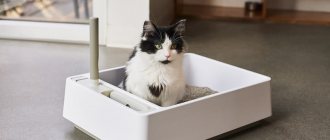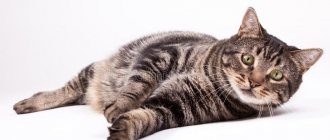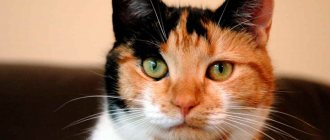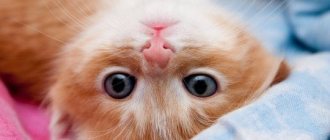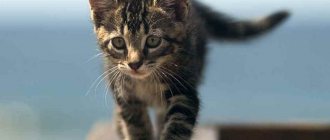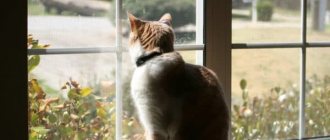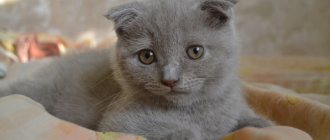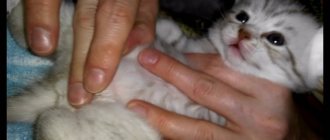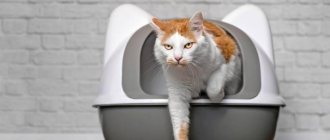When a small kitten appears in the house, considerable responsibility falls on the owner. One of the important factors in a pet’s health is the functioning of the digestive system. Simply put, how a kitten will feel is influenced by how often it visits the toilet. In our article we will talk about how long a pet should go to the toilet, and how to help him cope with this difficult moment.
How do newborn kittens go to the toilet?
Some novice cat breeders are of the opinion that a newborn kitten does not walk at all, not only in a big way, but also in a small way. However, this is an erroneous judgment. The fact is that during this period the mother cat carefully looks after him. It is she who massages the babies' anus and bladder with her rough tongue, while simultaneously licking everything that comes out of the anus. That is why the cat’s nest is clean and free of unpleasant odors. The kitten enjoys such courtship from the cat until about one month, after which everything falls on the attentive owner.
Causes of constipation
Constipation in cats develops somewhat less frequently than diarrhea.
The following reasons can provoke this phenomenon:
- incorrect feeding system with excess protein;
- dehydration, when stool becomes too hard and cannot pass out of the intestines;
- lack of movement leading to digestive disorders;
- intestinal obstruction (constipation is not the only symptom);
- the presence of hair in the intestines;
- severe stress (leads to constipation and diarrhea equally);
- hernias;
- tumors of a malignant or benign nature.
Giving an animal a laxative until the cause of the disorder is determined is unacceptable. The veterinarian will determine how to properly solve the problem.
How often should a one-month-old kitten go to the toilet?
In the first month of life, babies are preparing to go to the toilet on their own. At this time, their digestive tract is actively developing. Their intestines are strengthened and populated with beneficial bacteria, which helps them visit the litter box every day. If a kitten sucked the milk of its mother cat, with a gradual transition to complete food, this would have a good effect on the functioning of the digestive tract. The food should be creamy and finely chopped, which will help better passage through the intestines and the development of the digestive process.
Ideally, one-month-old kittens poop on their own approximately 3 to 6 times a day. Their feces should have a mushy consistency, without any mucus or undigested food. The owner should be alerted to the presence of loose stools. Sometimes it can be difficult to check the presence of feces at this age, since the kitten does not yet know how to use a litter box and relieves itself with great pleasure in different parts of the apartment. If the pet is cheerful and cheerful, full of energy, then there is no need to worry about the fact that you cannot calculate how often the cat walks. You can check the quality of the digestive system by examining the tummy. Healthy kittens have a soft and painless belly.
Elderly cats
Elderly individuals are less mobile, consume less food, which can cause digestive disorders. As a result, the norm is considered to be the appearance of feces in the tray once every two days.
The stool may have a soft or hard consistency. Their color is possible both light and dark. If an older pet feels fine and does not constantly scream due to pain or when going to the toilet, then there is no need to consult a veterinarian.
How often should a three month old kitten go to the toilet?
From the age of one month, the kitten switches to nutritious food. As a rule, up to three months his nutritional diet and, accordingly, the nature of his feces change. The feces become more shaped. You can understand how many times a day a kitten should go to the toilet by the nature of the baby’s diet. If his food includes plant fiber, then this process will occur more often, but if the food contains a large amount of protein, then less often. The most important thing during this period is that the cat poops every day, and that the feces are free of blood, mucus, and undigested food.
Regular feeding
While the kittens were lying in the above-mentioned basin, I found on the Internet that it is necessary to feed the orphans with a special cat's milk substitute, sold in veterinary pharmacies.
But 10% cream and regular high-fat milk are also suitable; sometimes you need to add 0.5 liters of raw yolk and 4 teaspoons of granulated sugar. I immediately went to the store. I used glass pharmacy vials from penicillin as bottles, and the rubber parts of ordinary pharmacy pipettes became the nipples. They calmly stretch onto the wide neck of the bubbles. But you need to immediately purchase about 20 pipettes. They are sometimes torn, sometimes lost, sometimes spoiled by the kittens’ rapidly growing teeth.
The milk needs to be heated, you can do it for 3-5 seconds in the microwave, check before feeding to see if it is too hot - in general, everything is the same as with human children. And, of course, you need to wash and dry the nipple pipettes and bubbles after each feeding. It is convenient to pour the daily portion of milk into a separate jar with a plastic lid, store the jar in the refrigerator, stick a 10 ml syringe with a needle into the lid, and use it to pour milk into the bottle through a hole in the nipple.
Kittens eat depending on the weather - sometimes every hour, sometimes every 3-4 hours in sleepy, cloudy weather. When they are full, they lean away from the nipple. At night, our kittens slept decently, giving me a rest from midnight until exactly 8-10 in the morning. Only on the first night they made me stay awake, eating every hour.
It is convenient to feed kittens in your arms, with their back facing you, holding them with one hand under their front legs and belly, and holding the bottle with the other. A hungry kitten will fiercely cling to the bottle, preventing itself from sucking on the nipple, so at the beginning of feeding you need to hold your paws, and then when the kitten is calmly sucking, let go, then he will wrap his paws around the bottle.
One and a half month old cats in the same box as in the previous picture. They learned to jump over the partition, so it was removed.
Eight month old cat in a box with a bottom the same size as a cardboard box.
At the age of 15-20 days, you can feed kittens with soaked dry food for kittens, a couple of crackers are enough, or natural food. We started with natural complementary foods, in mini quantities - rice, corn, buckwheat porridge, cottage cheese with sour cream, boiled chicken or beef. Our kittens refused to eat boiled vegetables.
When the kittens were constipated for longer than 3 days, I gave them a little Vaseline oil (from a syringe into the mouth), and did mini-enemas with warm soapy water (a syringe lubricated with Vaseline oil). Around the age of one and a half months, we switched to dry food and canned food for kittens, since the kittens refused to eat natural food.
How to determine that a kitten wants to go to the toilet?
Many inexperienced owners are afraid that they will not be able to determine when the kitten wants to poop. If a cat scratches the surface with its paws, the owner should transfer it to the tray as soon as possible. Usually the kitten understands from the first time what is required of him.
Another way to determine that a cat wants to go to the litter box is this behavior when he seems to sniff around, as if looking for a place. It is also worth looking at the pet’s eyes; if the owner sees that the cat seems to be glazed over, then he is definitely thinking about his goal. As soon as the cat begins to show such signs, it means that she wants to poop.
Treatment method and prognosis
There is no single treatment regimen for pollakiuria. Therapeutic procedures are prescribed after diagnosis. As mentioned above, pollakiuria can be a sign of a dangerous disease, so treatment will be aimed at eliminating it.
Thus, for diabetes mellitus, insulin therapy is an important stage of treatment. With the help of drip infusion of polyionic drugs, the water-salt balance is restored. The key to successful treatment and recovery or maintaining quality of life at a satisfactory level is nutritional correction and quality care.
It often happens that the pet will be limited in physical activity for the rest of its life, take appropriate medications and eat exclusively special medicinal food.
If pollakiuria is caused by stress, then, first of all, it is necessary to eliminate the source of psycho-emotional stress. To reduce the negative effects of stress, your veterinarian may prescribe anti-anxiety medications, such as Stop-Stress.
Cat marks are an unpleasant phenomenon, but an animal cannot be punished for it. The best way out would be castration or the sedative phytohormonal remedy Kot Bayun.
Antispasmodics are indicated to relieve pain; antibiotics and sulfa drugs are used to eliminate infections.
The prognosis for pollakiuria again depends on the underlying disease. If, for example, we are talking about an infection, then one course of antibiotic therapy is enough. But for malignant and benign diseases, veterinarians are no longer so optimistic in their forecasts.
Why do problems with stool occur?
If an older kitten with well-opened eyes eats and drinks well, but cannot walk around every day, then there are the following reasons for this:
- Stress. Very often, a kitten suffers from constipation due to stress. Early weaning from a cat has a particularly difficult effect. The kitten, missing its mother cat, sometimes experiences difficulty passing stool for 5 days. If kids in a new home cannot go to the toilet on their own during this time, then there is nothing wrong with that. If the situation does not resolve after 5 days, then you need to visit a veterinarian. You need to try to make the cat calm down; as soon as he gets used to his new place of residence, the situation should resolve itself.
- A kitten may have difficulty passing stool if it has an improperly balanced diet. When a cat finds itself in a new home, you should try to initially stick to the same menu as the old owners. It is best to use specially formulated food for babies. When a cat eats natural food, it is better to include plant foods, boiled meat, and cereals. After the new owners select suitable food for the babies, they themselves begin to go to the toilet. How many times a cat goes to the litter box depends on what it eats. He can go up to 4 times a day if he eats food rich in fiber; when eating meat, cats visit the litter box about 2 times a day.
- Another common cause is constipation. When a kitten cannot poop for about a week, it may have a health problem, which led to the development of a similar situation. In this case, the pet must be shown to a veterinarian; only he can correctly assess the situation and prescribe treatment.
Diarrhea in a cat, causes
Diarrhea in cats develops quite often . A one-time loose stool should not frighten the owner, since it is usually a failure that occurs due to minor reasons that do not require a visit to a specialist.
Diarrhea in cats develops quite often
Diarrhea for 2 days or more requires therapy.
There are several main causes of diarrhea in cats:
- Feed intolerance. The animal’s body may not accept the food offered, even when it is of high quality. Most often, the phenomenon is observed when giving low-grade ready-made feed and milk. The problem can be solved by adjusting the diet.
- Sudden change in diet. The cat's intestines and stomach must gradually adapt to the new diet. If it is changed abruptly, diarrhea will easily occur due to irritation of the mucous membrane.
- Worm infestation. The toxins released by worms lead to poisoning, causing loose stools.
- Metabolic disease. This affects most processes in the animal's body, including the number of bowel movements and the density of feces.
- Bowel disease. Diarrhea most often develops with infectious lesions, but may also indicate tumor neoplasms and various ulcerative pathologies. A blood test will be required for diagnosis.
A veterinarian can determine the exact cause of diarrhea in a cat after an examination.
Saucer training, education
The most difficult thing for us was to teach the kittens to lap up milk on their own and eat solid food from a saucer. They loved the bottle. We put small peas of complementary food into their mouths. Why should they give up such pleasure?
In general, kittens, obeying the feeling of hunger, begin to lap at 3-3.5 weeks from the saucer. But with us, they cried shrilly, poked at the saucer, sneezed from milk that got into their noses and could not understand what to do. There was no one to show how to lap; there were no adult cats or dogs nearby. A week of unsuccessful attempts passed, but then guests came to us - experienced cat breeders and in half an hour they taught the kittens to lap from a saucer.
We just learned to eat from a saucer.
If at 2-3 weeks the kittens are not yet playing, if you take them out of the nest - they can barely walk, waddling from side to side, and constantly squeak, then by 4 weeks they are already accomplished tomboys who have learned to climb onto the sofa, jump on a stool, bite and fight.
Forty-day-old kittens.
